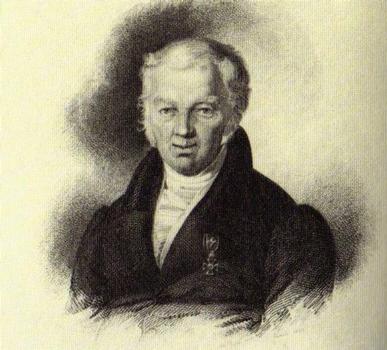Biographical Information
| Name: | Franz von Gerstner |
|---|---|
| Full name: | Franz Joseph von Gerstner |
| Born on | 23 February 1756 in Chomutov, Ústí nad Labem Region, Czechia, Europe |
| Deceased on | 25 June 1832 in Mladějov, Hradec Králové Region, Czechia, Europe |
Short biography of Franz von Gerstner
During his secondary education the young Gerstner made himself known to the local tradesmen in his home town. From 1773 to 1779 he studied at the University of Prague where he heard lectures on philosophy, theology, Greek, Hebrew, elementary mathematics, astronomy and higher mathematics. Some of his earnings came through playing the organ and private mathematics and physics pupils. Despite his speech impediment, he undertook two public doctor examinations on astronomy and Newton’s Principia, which he passed with flying colours. Afterwards, he served as a surveyor on a royal commission which was set up by Emperor Joseph II in the course of abolishing serfdom. Inspired by the Emperor’s vision, Gerstner studied medicine but still retained a serious interest in questions of astronomy and mathematics. In 1789 he published his introduction to structures and architecture, which became an important document in the initial phase of structural theory. That same year saw him appointed professor of higher mathematics at the University of Prague, where he was soon able to raise the numbers of students attending lectures from three or four to 70 or 80. One of those who attended was the later mathematician and philosopher Bernard Bolzano (1781–1848), whose genius was recognised by Gerstner and who did everything he could to help him. Five years after the death of his mentor, Bolzano wrote a biography as a tribute [Bolzano, 1837]. Gerstner’s interests focused more and more on “advancing the commerce of the Fatherland through scientific teaching” [Gerstner, 1833, p. V]. With this in mind he founded the Prague Polytechnic in 1806 on behalf of the Bohemian Parliament and remained its director until 1822, responsible for mathematics and mechanics. In 1811 the Emperor appointed him director of hydraulic engineering of Bohemia; Gerstner became a valued adviser for countless engineering projects in his country of birth. In the 1820s he built the first railway line in continental Europe – the horse-drawn railway between Linz and Budweis – together with his son Franz Anton. His son also helped him with the publishing of his three-volume Handbuch der Mechanik, although this was not completed until after his death. Gerstner’s Handbuch was the first independent work on applied mechanics in the German language and represents the constitution phase of this fundamental discipline of engineering science; not until many decades later did the theory of structures achieve emancipation from this in the German-speaking countries.
Main contributions to structural analysis:
Einleitung in die statische Baukunst [1789]; Handbuch der Mechanik [1831–1834]
Source: Kurrer, Karl-Eugen The History of the Theory of Structures, Wilhelm Ernst & Sohn Verlag für Architektur und technische Wissenschaften GmbH, Berlin (Deutschland), ISBN 3-433-01838-3, 2008; p. 733
Relevant Publications
- (2008): The History of the Theory of Structures. From Arch Analysis to Computational Mechanics. 1st edition, Wilhelm Ernst & Sohn Verlag für Architektur und technische Wissenschaften GmbH, Berlin (Germany), ISBN 978-3-433-01838-5, pp. 848.
- (2018): The History of the Theory of Structures. Searching for Equilibrium. 2nd edition, Wilhelm Ernst & Sohn Verlag für technische Wissenschaften, Berlin (Germany), ISBN 978-3-433-03229-9, pp. 1000.
- (2006): Das Verhältnis von Bautechnik und Festigkeitslehre in Gerstners "Handbuch der Mechanik" - Zum 250. Geburtstag von Franz Joseph Ritter von Gerstner. In: Stahlbau, v. 75, n. 7 (July 2006), pp. 586-597.
- About this
data sheet - Person-ID
1009821 - Published on:
11/08/2013 - Last updated on:
22/07/2014




